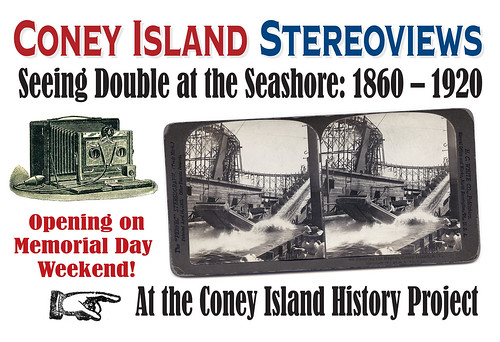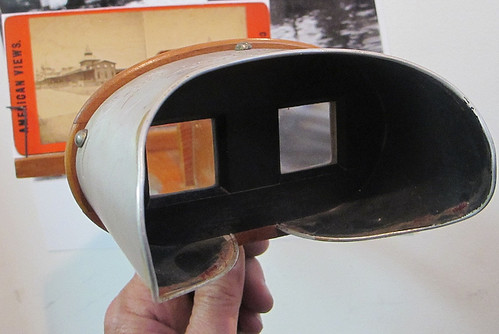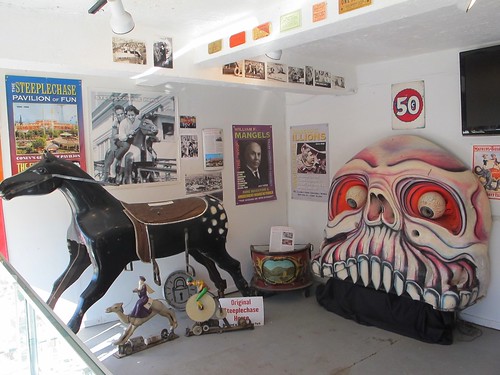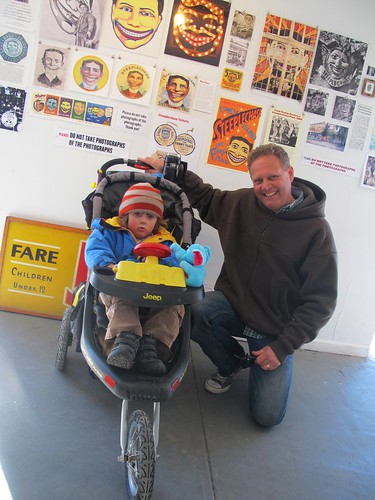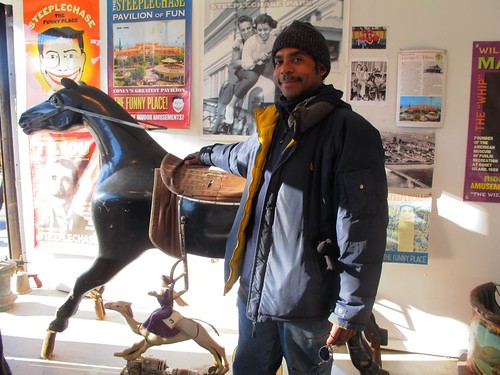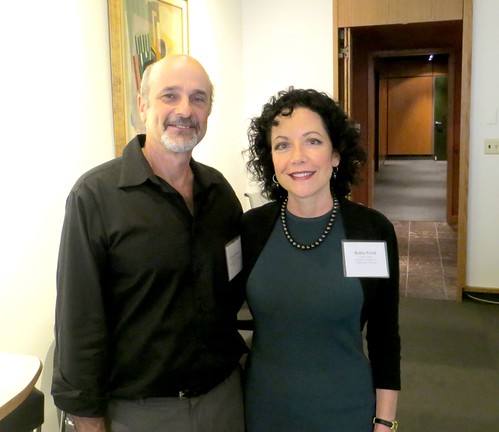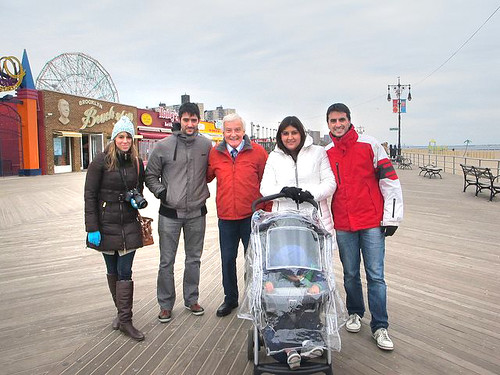Our first special exhibit of the season, opening on May 23, will be "Coney Island Stereoviews: Seeing Double at the Seashore, 1860-1920." Stereoview photography of Coney Island began in the 1860s, providing the earliest documentation of the resort. This exhibit features original stereoview photo cards, antique stereo viewers, and enlargements of some of the oldest photographic images of Coney Island.
Long before television, radio, movies, and the internet, the main form of family home entertainment was an exciting new technology called stereoview photography. Most homes could afford a simple wooden hand viewer and a collection of stereoview cards that covered every subject imaginable.
The cards were actual photographs shot with a stereo bellows camera and pasted on a cardboard backing. The viewer split the card, creating a 3-D image, something that had never been possible before.
Coney Island was one of the earliest subjects photographed. During the 1860s Coney Island consisted of a tiny resort centered on Coney Island Creek at the terminus of Shell Road. The Coney Island Tollhouse, Wyckoff House and Oceanic Hotel were prominently featured in these vintage stereoviews, as was Coney Island Creek itself. Hunting, fishing and rowing on the creek were the main attractions in the resort's early days.
Late 19th century images included the Elephant Hotel, the first roller coasters, and a variety of humorous bathing attire. Our exhibit features modern enlargements of these early images, as well as the cards themselves. Commercial stereoviews continued to sell well into the 1930s.
While this form of stereo technology may seem primitive by modern standards, visitors to our exhibit can peer through an antique stereoviewer and experience the earliest days of Coney Island as it was transformed into the "Playground of the World."
"Please join us on this journey into the heart of Coney Island and leave the digital world behind," says Charles Denson, curator of the exhibit and director of the Coney Island History Project.
This program is supported, in part, by the New York City Department of Cultural Affairs in partnership with the City Council, and our members and contributors.
Located on West 12th Street at the entrance to Deno's Wonder Wheel Park, the Coney Island History Project is just a few steps off the Boardwalk. View historic artifacts, photographs, maps, ephemera and films of Coney Island's colorful past. Visitors are also invited to take free souvenir photos with an original Steeplechase horse from the legendary ride that gave Steeplechase Park its name and "Skully," a giant skull that is a veteran of Coney's Spookhouse and Spook-A-Rama.
The History Project's exhibition center season is from Memorial Day Weekend through Labor Day on Saturdays, Sundays and holidays. New hours are 1:00PM till 7:00PM. Admission is free of charge.
Join our unique walking tours based on Charles Denson's award-winning book Coney Island: Lost and Found, the interviews from CIHP's Oral History Archive, and other primary sources. Visit our online reservation site to see the walking tour schedule and purchase advance tickets online or book a group tour.

You're invited to It's My Estuary Day on May 30 from 10:00AM-4:00PM, a day of service, learning and celebration along Coney Island Creek in Kaiser Park! The rain date is Sunday May 31.
Events will include a coastal clean-up, tables representing environmental organizations, demonstrations of water chemistry techniques, oyster monitoring projects, underwater robotics, diving demonstrations, and eco-chats with scientists and ecologists.
Participants include: NYCDOE * NYC Department of Environmental Protection * New York State Department of Environmental Conservation * NYC Partnerships for Parks * NYC Department of Sanitation * New York Aquarium * New York State Marine Education Association (NYSMEA) * Coney Island History Project * US Navy Sea Perch Project * Billion Oyster Project * The Historical Diving Society * Coney Island Beautification Project * Atlantic Engineering * Brooklyn Marine Alliance * Captain Mikes Diving * Cultural Research Divers * The Northeast Diving Equipment Group * Parachute Literary Arts * Union Divers Local 1556 * IS 228 * John Dewey High School * PS 188 * Rachel Carson High School for Coastal Studies
Charles Denson of the Coney Island History Project will give a talk and tour of Coney Creek at It's My Estuary Day. Visitors may also take a self-guided walking tour by following the markers created for the Coney Island CreekWalk by the History Project with the support of Partnerships for Parks.
Last month, Charles Denson launched http://www.coneyislandcreek.org, his new website about Coney Island Creek. "I felt that it was important to create a site that provides a resource for people interested in discovering the creek's history and ecology, and its potential for the future." he said. "It's important for the public to be informed and have a voice as the city is conducting a feasibility study to mitigate future flooding in the area and the waterway might be transformed in many ways in the near future."
The site will have videos, photo essays, maps, interviews with community members, news, and historical photographs and information. Among the first videos on the new site is this kayak tour of the Creek at high tide.

Italian immigrants celebrating the Feast of the Assumption of Mary on the beach with Antonetta DelCore, "Queen of Coney Island" from the 1940s until her death in 1973.
Today as always, visitors of every age, race, color, and country of origin mingle on Coney Island's beach and boardwalk. In the late 19th and early 20th century, it was German, Italian and Greek immigrants, now it's Russian, Chinese, Pakistani and Haitian families, among others, who have settled in Coney Island and the adjacent neighborhoods of Gravesend, Bensonhurst and Brighton Beach.
The Coney Island History Project is seeking Southern Brooklyn immigrants to record oral histories for a new program debuting this year. As part of the New York City Council's citywide Cultural Immigrant Initiative, we are conducting interviews with immigrants and foreign-born New Yorkers in English as well as languages such as Chinese and Russian.
Please email events[AT]coneyislandhistory[DOT]org for info or to schedule an appointment if you or someone you know would like to share a story. Interviews may be conducted at our recording studio or your home or office, as well as at senior centers and community centers, where we will be presenting slide talks about the history of immigrants in Coney Island.
This program is supported, in part, by the New York City Department of Cultural Affairs in partnership with the City Council, and New York City Councilman Mark Treyger.

Red Grooms, Weegee 1940, 1998-99, acrylic on paper, Private Collection. Image Courtesy Marlborough Gallery, New York; © 2013 Red Grooms/Artists Rights Society (ARS), New York
On May 12th, the New York Public Library will host a conversation inspired by Coney Island: Visions of an American Dreamland, 1861-2008, the exhibit at the Wadsworth Atheneum Museum of Art and the Yale University Press publication of the same title. The panelists are the exhibit's curator Robin Jaffee Frank (Wadsworth Atheneum), Charles Denson (Coney Island History Project), Terry Carbone (Brooklyn Museum), Charles Musser (Yale University), and guest artist Red Grooms.
The Art Book Series event will be held from 6:00pm-8:00PM at the 42nd Street Library's Stephen A. Schwarzman Building. The event is free to the public. Auditorium doors open at 5:30PM.
Charles Denson has been a consultant and a member of the exhibit's project team for the past five years and has contributed numerous ephemera and prints from his personal archive, as well as writing a chapter for the exhibit catalog.
The exhibit Coney Island: Visions of an American Dreamland is on view in Hartford through May 31 before traveling to the San Diego Museum of Art, July 11, 2015 - October 13, 2015; Brooklyn Museum, November 20, 2015 - March 13, 2016; and the McNay Art Museum in San Antonio, May 11, 2016 - September 11, 2016. It features more than 140 paintings, drawings, photographs, prints, posters, architectural artifacts, carousel animals, ephemera and film clips.
Polar Bear Club Member Eddie Mark and Coney Island City Councilman Mark Treyger pose for a souvenir photo with 'Skully,' a veteran of Spook-A-Rama and the Spookhouse, and the newest addition to our exhibit center.
After special hours on Palm Sunday and Easter, the History Project is currently open for weekend walking tours and group visits. Visit our online reservation site to see the walking tour schedule and purchase advance tickets online. For info on booking a group tour, email events@coneyislandhistory.org.
This 3-year-old, one of our youngest visitors, and his dad are regulars at Coney Island Always, the miniature animated amusement park in the window next door.
The Steeplechase Park fan seen below poses with our original Steeplechase horse from the legendary ride that gave the park its name. Visit our flickr page to view more photos from Opening Day and Easter
Our regular exhibition season is from Memorial Day Weekend through Labor Day on Saturdays, Sundays and holidays. New hours in 2015 will be from 1:00PM till 7:00PM. Admission is free of charge.
You're invited to preview the Coney Island History Project's exhibition center season on Coney's Opening Day. View historic artifacts, photographs, maps, ephemera and films of Coney Island's colorful past and preview selections from upcoming exhibits. Among the new additions for Opening Day is "Skully," a Giant Skull which came from the Coney Island Hysterical Society's Spookhouse, formerly the Dragon's Cave dark ride, and later found a home at Spook-A-Rama, thanks to Deno's Wonder Wheel Park's Vourderis family. Like the Spook-A-Rama Cyclops, which was previously on display at the History Project, the Skull's eye sockets light up, and will soon move again with a little electrical work.
Dark ride veteran 'Skully' poses for his first souvenir photo at our exhibit center with Steve Vourderis, Denos Vourderis and Charles Denson. Take a selfie with him on Opening Day!
Located on West 12th Street at the entrance to Deno's Wonder Wheel Park, the Coney Island History Project will be open on Palm Sunday, March 29th, and again on Easter Sunday, April 5th, from 1:00PM till 6:00PM. Our regular exhibition season is from Memorial Day Weekend through Labor Day on Saturdays, Sundays and holidays. New hours will be from 1:00PM till 7:00PM. Admission is free of charge.
Our first special exhibit of the season, opening on Memorial Day Weekend, will be "Coney Island Stereoviews: Seeing Double at the Seashore, 1860-1920." Stereoview photography of Coney Island began in the 1860s, providing the earliest documentation of the resort. This exhibit features original stereoview photo cards, antique stereo viewers, and enlargements of some of the oldest photographic images of Coney Island.
Join our unique walking tours based on History Project director Charles Denson's award-winning book Coney Island: Lost and Found, the interviews from CIHP's Oral History Archive, and other primary sources. Tours and group visits to the exhibit center are given year-round. Visit our online reservation site to see the walking tour schedule and purchase advance tickets online or book a group tour.
Palm Sunday is the official season opener for Coney Island's rides and attractions. The Opening Day celebration starts at 10:30AM on the Boardwalk with the annual tradition of the Blessing of the Rides at Deno's Wonder Wheel Park by Pastor Debbie Santiago of Coney Island's Salt and Sea Mission. Built in 1920 by the Eccentric Ferris Wheel Company, Deno's Wonder Wheel is celebrating its 95th season with a free ride on Opening Day for the first 95 riders. At the 1927 Cyclone, where the first 100 people on line ride for free, the annual Egg Cream Christening of the roller coaster's front car is at 12 noon. The Wonder Wheel and the Cyclone are official New York City Landmarks.
At the Coney Island History Project, visitors are invited to take a FREE souvenir photo with "Skully" or our original Steeplechase horse from the ride that gave Steeplechase Park its name. Hope to see you at this year's festivities!
Official Trailer: Coney Island: Visions of an American Dreamland, 1861-2008
On Saturday, February 28th, Charles Denson will present a slide talk on the Coney Island History Project's mission and origins as part of the Wadsworth Atheneum Museum of Art's Coney Island Symposium: An Intersection of Art and Identity. The exhibit Coney Island: Visions of an American Dreamland, 1861-2008, which opened on January 31st at the Wadsworth, features more than 140 paintings, drawings, photographs, prints, posters, architectural artifacts, carousel animals, ephemera and film clips. The symposium begins with a keynote address by Exhibition Curator and Chief Curator Robin Jaffee Frank, followed by a series of panel discussions and special presentations.
Charles Denson has been a consultant and a member of the exhibit's project team for the past six years and has contributed numerous ephemera and prints from his personal archive, as well as writing a chapter for the exhibit's catalog. He also recorded descriptions of artwork for the show's audio tour. Selections from the Coney Island History Project's vast archive of oral history recordings were used in the "Step Right Up!" interactive listening station that accompanies the show.
"Robin Jaffee Frank first contacted me in 2009, during the show's earliest planning stage," Denson said. "At our first group meeting at the Yale University Art Gallery in 2010, Robin revealed her ambitious plan for a show that explored Coney Island in a way that had never been attempted before. Her Coney Island theme included artifacts, prints, film, sheet music, and the best examples of modern art as well as the classical paintings that depict the earliest years of Coney Island, a subject that I had always found fascinating. I am extremely honored to be a part of this exhibition."
Charles Denson and Robin Jaffee Frank, 2012
Among the artifacts in the Wadsworth exhibit is the 1955 Spook-A-Rama Cyclops, which was a popular attraction at the Coney Island History Project's exhibit center for the past two years. According to a review of the Wadsworth show in the Hartford Courant, "The five-foot-tall wall-mounted sculpture, loaned to the exhibit by the family who runs Deno's Wonder Wheel Amusement Park, is installed at the entrance to the exhibit galleries, flanked by two creepy paintings by Arnold Mesches, in which Cy presides over sinister-looking amusement parks."
The Coney Island exhibit is on view in Hartford through May 31, 2015 before traveling to the San Diego Museum of Art, July 11, 2015 - October 13, 2015; Brooklyn Museum, November 20, 2015 - March 13, 2016; and the McNay Art Museum in San Antonio, May 11, 2016 - September 11, 2016.
Deno's Wonder Wheel Park's Stacy Vourderis visiting the park's Spook-A-Rama Cyclops, which is part of the Coney Island exhibit at the Wadsworth Atheneum in Hartford, CT
After closing his Mermaid Avenue market in 2009, Jimmy Prince, now 82, remains active and was profiled in New York Magazine’s “My Day.” In the summer, he volunteers at the Coney Island History Project exhibit center, where his longtime customers are delighted to see him again.
“Prince of Mermaid Avenue,” a film about Jimmy Prince by History Project Executive Director Charles Denson, is now available for viewing on his Coneyologist channel on YouTube. The film won Best Documentary at the 2009 Coney Island Film Festival. This 60-minute feature is based on more than 60 hours of raw footage shot over a three-year period.
Jimmy Prince was the last link to what Mermaid Avenue meant to Coney Island in the “good old days.” The Avenue was once a bustling street of family-run mom-and-pop stores. Each block had bakeries, luncheonettes, five-and-dimes, clothing and shoe stores, furniture stores, delis, and butchers. It was a tight-knit community.
The city’s urban renewal plan of the 1960s called for the demolition of the entire West End, including Mermaid Avenue, and few businesses survived the development onslaught. Jimmy Prince transformed his Major Meat Market into the soul of an earlier era, a cordial oasis of tradition and hope, a throwback to what Coney Island was and what many dreamed it could be again one day. Prince worked at Major’s for sixty years, seven days a week, twelve hours a day, and formed a unique relationship with a community that hungered for respect.
When he finally faced retirement,the decsion to close the store dragged on for over a year. He dreaded making a formal announcement about the store’s closing, but his friends could sense it was coming. His loyal customers expressed their love for him and their fear for a future without him. This film documents Jimmy’s decision to retire and the painful process of leaving the Coney Island community that he loved and supported for so many years.
Jimmy Prince poses for photo with visitors from Spain on a recent Coney Island History Project Walking Tour. The Prince of Mermaid Avenue, who had just come from a walk to and from Sea Gate and a bite to eat at Tom's, stopped to regale the group with Coney Island stories
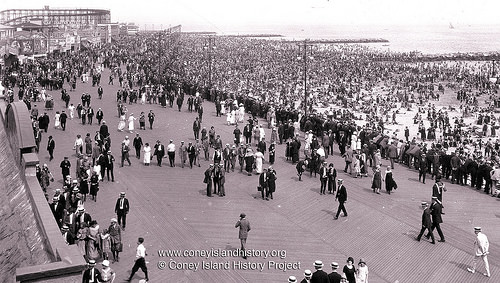
Boardwalk scene circa 1925. © Coney Island History Project Archives
Last December Councilmembers Mark Treyger and Chaim M. Deutsch sent a petition to the Landmarks Preservation Commission asking that the Coney Island Boardwalk be declared a scenic landmark. On December 17 the council members received a condescending and dismissive rejection letter from LPC Director of Research Mary Beth Betts. The letter outlined the reasons for refusal to grant Scenic Landmark status.
The commission’s response to Councilmember Treyger is troubling on many levels, the first being that the contents of the letter were lifted from a 2012 letter written by then LPC Chairman and Bloomberg appointee Robert Tierney. In addition to the “form letter” being an inappropriate response to the two elected officials, all of the reasons stated for the refusal do not apply to the Boardwalk.
Ms. Betts gave the following reasons for denying scenic landmark status: “The boardwalk was substantially altered by Robert Moses in 1939-41 from its original location and configuration. [And was] at this time straightened and extended east. The planks of the Boardwalk have been replaced numerous times over the years. . .”
To understand how ludicrous this reasoning is, one has to look at Ocean Parkway, a local Scenic Landmark granted landmark status in 1975. Ocean Parkway was originally a dirt road lighted by gas lamps. By the time it became a Scenic Landmark, the parkway had been resurfaced with asphalt, had its bridle path removed, and had been significantly altered when its northern end was cut off and put below grade as the entrance to the Prospect Expressway. Despite these alterations, Ocean Parkway still became a landmark. Therefore, a surfacing change and alterations should not affect the landmark status of the Boardwalk.
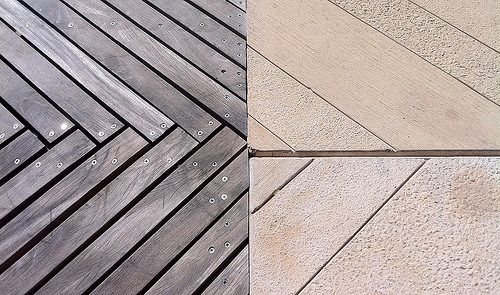
Wood and concrete sections of Coney Island-Brighton Beach Boardwalk. Photo © Charles Denson
The LPC’s statement that “the Boardwalk was substantially altered” and moved from its original location is also untrue. Only a five-block section of the 2.7-mile structure was moved, and the new section was built to the original specifications.
Perhaps the most shocking reason for denying landmark status was the staff’s incredulous statement that the Boardwalk has no historical or cultural significance. “In the opinion of the staff,” they pompously declare, “the most important period of significance in the history of Coney Island as a seaside resort pre-dates the construction of the boardwalk.”
While the staff’s inaccurate reasoning about “alterations and surfaces” can be attributed to sloppy research, their statement that the 1920s were not a “significant” period in Coney Island’s history shows an astounding display of ignorance. For some unknown reason, the staff has decided to downplay Coney Island’s important post-World War I history. And this despite the fact that nearly all of Coney’s designated landmarks are from that period.
During the 1920s, following the closure of the race tracks and elite hotels, Coney Island became the “People’s Playground.” The shorefront was expanded and reclaimed by the city and opened to the public, and the Boardwalk was opened and became the island’s Main Street, celebrated in legend and song. New theaters and hotels were constructed, public transit brought millions to the shore, and the Boardwalk, free to all, was the centerpiece. It was the symbol of Coney Island’s resurrection. Even from an engineering viewpoint, the Boardwalk has great importance. The structure was built in the ocean surf and the beach built around it, the first time hydraulic pumping had been used to create an artificial beach.
The following are the Landmark Commission’s stated criteria for a scenic landmark:
To become a scenic landmark, an outdoor site must be: At least 30 years old and have "a special character or special historical or aesthetic interest or value as part of the development, heritage, or cultural characteristics of the City, state, or nation" Any landscape feature or aggregate of landscape features
The Boardwalk meets every one of these requirements. It’s certainly one of the most scenic locations in New York City. The historic battle to reclaim the shorefront it stands on, the engineering breakthroughs enabled its construction, and the important role it plays in the lives of both visitors and residents are indisputable. In denying scenic landmark status to the Boardwalk, the landmarks commission seems to be failing in both mission and competence.
Granting landmark status can be a very political and controversial subject. We are all aware of that. But sending public officials a hackneyed, ill-informed retread opinion is insulting and discourteous. Commissioner Srinivasan and her research staff should be ashamed.
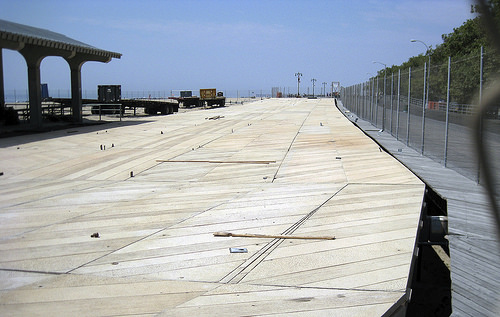
Concrete section of boardwalk in Brighton Beach. Photo © Charles Denson
Coney Island’s Boardwalk is under attack on many fronts. The recent decision to create a concrete Boardwalk will turn out to be a tremendous failure. Individual wooden boards can be replaced, but the massive concrete panels being installed cannot be removed and will have to be patched as the surface cracks from weathering over the next few decades. This pockmarked concrete surface will create hazards much greater than the ones now experienced by Boardwalk strollers and will be harder to repair. Alternatives to concrete must be explored before it is too late. Coney Island’s iconic wooden Boardwalk must be protected, restored, and preserved for future generations.
Charles Denson
There will be a rally on Sunday, January 18 to preserve and protect our historic Boardwalk. The rally will be in Brighton Beach on the Boardwalk at Coney Island Ave.(B or Q subway to Brighton Beach stop and then one block walk to the Boardwalk).


